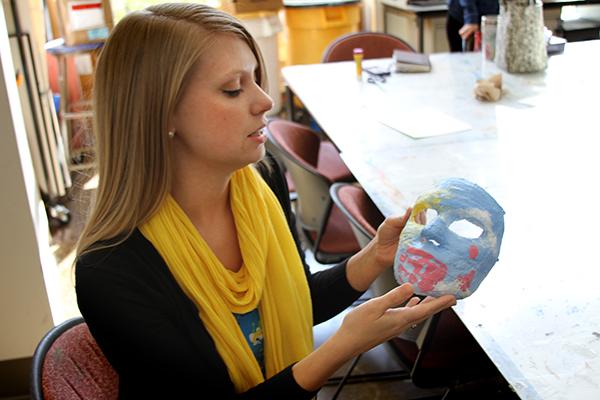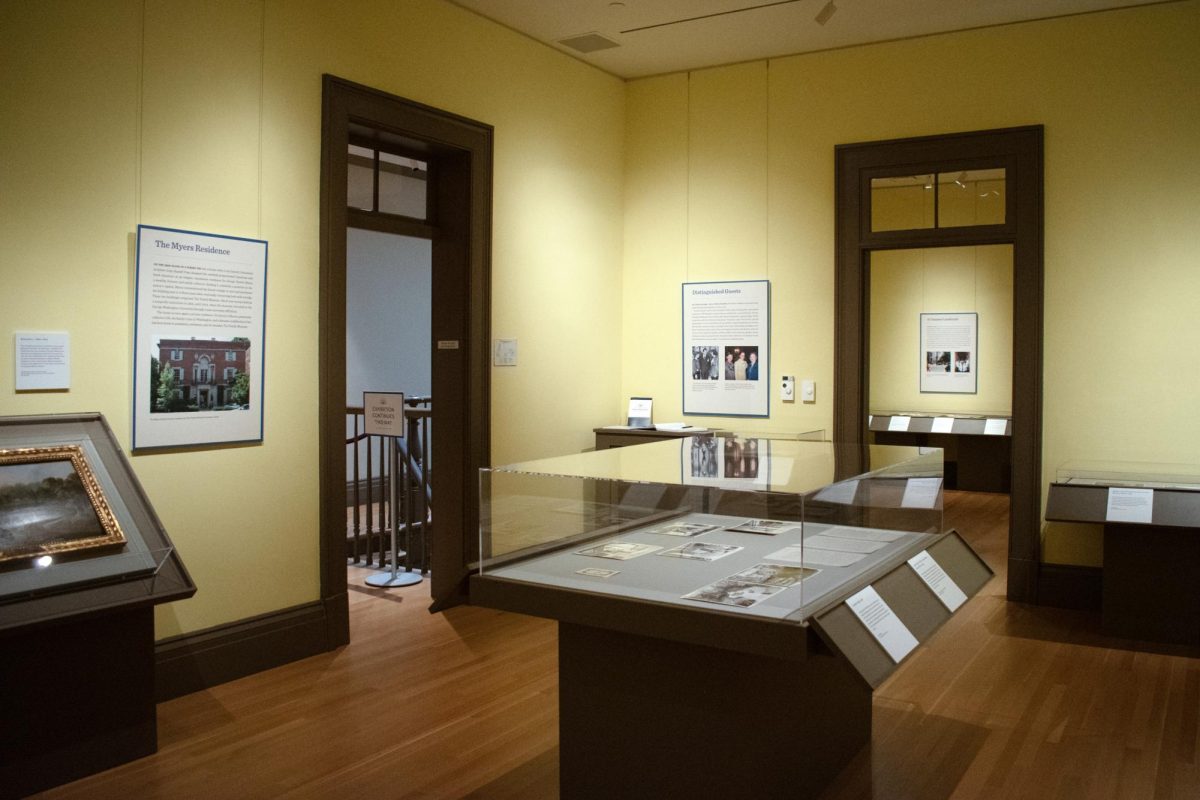In a large, cluttered Arlington, Va. studio flushed with sunlight, two art therapy graduate students sit quietly working, surrounded by bright jars of paint, muddled brushes and filled canvases.
While Stephanie Kurtyka works in her journal, Jessica Herman contemplates her latest creation: A papier-mâché mask painted with clouds in light blue and pink hues, which is meant to represent herself as a young girl.
“In my adolescence, my bed had [images of] clouds, so I put that, and I was very quiet, so I painted a hand over my mouth,” Herman said.
Herman said she will one day complete the same project with her clients. But first, she will finish the project on her own, so she can better understand the creative process.
The University’s art therapy program was founded in 1971 by a pioneer in the field, Elinor Ulman, making it the fourth-oldest of the 35 graduate degree programs in the country recognized by the American Art Therapy Association.
Art therapy aims to help clients express themselves through creating art, tapping into inner feelings that cannot easily be expressed, with mediums ranging from paint and sketching to origami and sand sculpture.
But art therapy involves more than just using creative means to de-stress.
Program director and alumna Heidi Bardot said art is a unique form of therapy because it frees the mind of thoughts that words cannot explain. While traditional talk therapy can hinder clients with words, art therapy is a boundary-free zone of expression.
“The artwork, we believe, is a mirror of the person creating it. So whatever you create is you,” she said. “It taps into your unconscious, it taps into the issues that you’re dealing with. There’s always a way to figure out what’s going on with creating a piece of art because it kind of sneaks past those verbal defenses.”
In a typical art therapy session at the program’s clinic, a client may be asked to paint, sketch or draw a scene from his or her life, like an embarrassing moment in childhood or a family portrait. Sometimes, clients opt to choose their own materials and work without directions.
Bardot said in art therapy, it is the client who leads his or her own recovery, and art therapists cannot simply look at a work of art and decipher its message.
Instead, the client’s expression comes first in the form of art, and is followed by a discussion of what it might mean. Though therapists may look for cues in the art – for example, a client depicting him or herself much smaller than other figures in a drawing – there is no notion of universal symbols.
“We don’t just go up to a piece and analyze it. We need to know what the story is. The black cloud for one person could mean depression, and for another it could mean that they’re finally getting rain for their crops,” Bardot said. “We’re not mind-readers.”
Researchers argue that an inability to find words to express oneself is more than just a feeling. Tally Tripp, the director of the University’s art therapy clinic and an alumna of the graduate program, said it could have a biological basis.
Tripp, who teaches a year-long course on trauma therapy, said victims of trauma often have disrupted brain structures that prevent them from verbalizing thoughts about their experiences. Trauma can result in a shutdown of a region of the brain called Broca’s area, which controls speech. That makes it difficult – if not impossible – for victims to explain and work through their feelings.
That’s where art therapy comes in. Where words fail, trauma survivors can express locked-up feelings with art.
“You know how sometimes if you’re hungry, you can say, ‘Oh, I’ll get to eat a little bit later,’ but you can’t think yourself out of being hungry. If your body is feeling fear, you can’t tell yourself not to be scared,” Tripp said. “Art therapy is a really expressive way to deal with those kinds of feelings, because that doesn’t require words.”
This discovery dates back to post-World War II Europe, when soldiers were returning from combat with feelings of numbness and heightened startle responses called “shell shock,” a condition doctors now diagnose as post-traumatic stress disorder.
With the help of art therapy, many soldiers were able to both distract themselves from their traumatic memories and express their feelings in a safe, non-threatening setting. But without art, most clients struggled to explain their thoughts.
“It’s similar to when you have a dream, and you wake up and try to describe it to someone, and it kind of just slips away because you can’t put those words to really describe your feelings,” Bardot said.
After World War II, Tripp said, many of the practitioners who had treated soldiers with art therapy moved to the U.S. to continue their research. For some of them, the first destination was GW.
Elinor Ulman, now recognized as a trailblazer of the field, founded both “The Bulletin of Art Therapy,” a publication now known as the “American Journal of Art Therapy,” in 1961 and the American Art Therapy Association in 1969. Two years later, Ulman, an assistant professorial lecturer at GW at the time, and Bernard Levy, a former psychology professor at the University, received approval to found an art therapy program.
Tripp herself was inspired to apply to GW when, as a student in high school, she learned about Ulman’s work through a friend who worked for the American Journal of Art Therapy.
“Here it is, 30 years later, and I’m one of the professors,” Tripp said, laughing.
When the program began, it was home to only 10 students. Forty-three years later, the program still retains its intimate feel – with 64 enrolled students, it is roughly the size of an average college class.
Though small, the program has big aspirations for the emerging field, and includes a team of five full-time faculty and 20 adjunct faculty with innovative ideas. Tripp, for example, is interested in the way that art therapy utilizes imagination to shift patterns of thinking to be more future-oriented.
Sometimes, Tripp will ask clients to draw a picture of a difficult or embarrassing moment (say, stuttering while giving a speech to a class). Then, she will ask the client to draw the same scene again, but this time, depicting what he or she would like to have happened.
“As you’re doing that, your brain is starting to adjust and picture a more positive response. What happens when we’re overwhelmed and stressed is we can’t imagine a different ending,” Tripp said. “Art therapy allows you to create a different feeling about who you are and that you’re different from who you were back then.”
She said art therapy relies on the idea that clients aren’t just talking about their problems, but actively doing something with them.
“It’s not just, you know, let’s sit back and analyze this,” Tripp said. “It’s much more, if you could draw a picture of what you would like to see yourself doing, what would that look like? And the picture will all of a sudden take off.”







